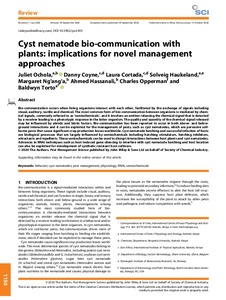| dc.contributor.author | Ochola, J. |
| dc.contributor.author | Coyne, D. |
| dc.contributor.author | Cortada-Gonzalez, L. |
| dc.contributor.author | Haukeland, S. |
| dc.contributor.author | Ng'ang'a, M. |
| dc.contributor.author | Hassanali, A. |
| dc.contributor.author | Opperman, C. |
| dc.contributor.author | Torto, B. |
| dc.date.accessioned | 2021-03-09T10:08:18Z |
| dc.date.available | 2021-03-09T10:08:18Z |
| dc.date.issued | 2020-09-28 |
| dc.identifier.citation | Ochola, J., Coyne, D., Cortada-Gonzalez, L., Haukeland, S., Ng'ang'a, M., Hassanali, A., ... & Torto, B. (2021). Cyst nematode bio‐communication with plants: implications for novel management approaches. Pest Management Science, 77(3), 1150-1159. |
| dc.identifier.issn | 1526-498X |
| dc.identifier.uri | https://hdl.handle.net/20.500.12478/7071 |
| dc.description.abstract | Bio‐communication occurs when living organisms interact with each other, facilitated by the exchange of signals including visual, auditory, tactile and chemical. The most common form of bio‐communication between organisms is mediated by chemical signals, commonly referred to as ‘semiochemicals’, and it involves an emitter releasing the chemical signal that is detected by a receiver leading to a phenotypic response in the latter organism. The quality and quantity of the chemical signal released may be influenced by abiotic and biotic factors. Bio‐communication has been reported to occur in both above‐ and below‐ground interactions and it can be exploited for the management of pests, such as cyst nematodes, which are pervasive soil‐borne pests that cause significant crop production losses worldwide. Cyst nematode hatching and successful infection of hosts are biological processes that are largely influenced by semiochemicals including hatching stimulators, hatching inhibitors, attractants and repellents. These semiochemicals can be used to disrupt interactions between host plants and cyst nematodes. Advances in RNAi techniques such as host‐induced gene silencing to interfere with cyst nematode hatching and host location can also be exploited for development of synthetic resistant host cultivars. © 2020 The Authors. Pest Management Science published by John Wiley & Sons Ltd on behalf of Society of Chemical Industry. |
| dc.description.sponsorship | CGIAR Research Program on Roots, Tubers and Bananas |
| dc.description.sponsorship | North Carolina State University |
| dc.description.sponsorship | Bill & Melinda Gates Foundation |
| dc.format.extent | 1150-1159 |
| dc.language.iso | en |
| dc.subject | Behaviour |
| dc.subject | Nematoda |
| dc.subject | Pest Management |
| dc.subject | Physiology |
| dc.subject | Semiochemicals |
| dc.title | Cyst nematode bio-communication with plants: implications for novel management approaches |
| dc.type | Journal Article |
| cg.contributor.crp | Roots, Tubers and Bananas |
| cg.contributor.affiliation | International Centre of Insect Physiology and Ecology |
| cg.contributor.affiliation | International Institute of Tropical Agriculture |
| cg.contributor.affiliation | Kenyatta University |
| cg.contributor.affiliation | North Carolina State University |
| cg.coverage.region | Africa |
| cg.coverage.hub | Eastern Africa Hub |
| cg.researchtheme | Biotech and Plant Breeding |
| cg.researchtheme | Natural Resource Management |
| cg.identifier.bibtexciteid | OCHOLA:2021 |
| cg.isijournal | ISI Journal |
| cg.authorship.types | CGIAR and developing country institute |
| cg.iitasubject | Aflatoxin |
| cg.iitasubject | Pests of Plants |
| cg.journal | Pest Management Science |
| cg.accessibilitystatus | Open Access |
| cg.reviewstatus | Peer Review |
| cg.usagerightslicense | Creative Commons Attribution 4.0 (CC BY 0.0) |
| cg.targetaudience | Scientists |
| cg.identifier.doi | https://dx.doi.org/10.1002/ps.6105 |
| cg.iitaauthor.identifier | Daniel Coyne: 0000-0002-2030-6328 |
| cg.iitaauthor.identifier | LAURA CORTADA: 0000-0002-5953-3798 |
| cg.futureupdate.required | No |

